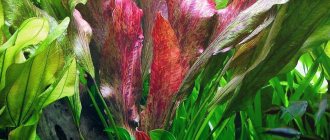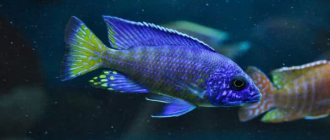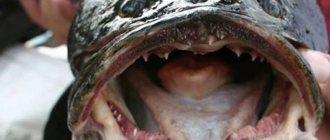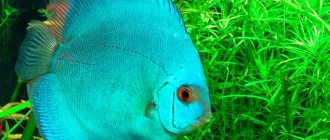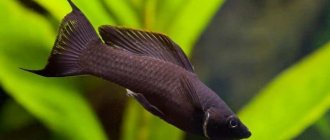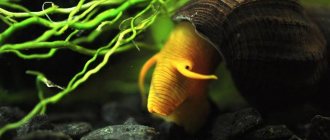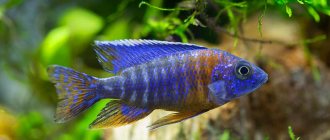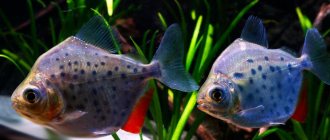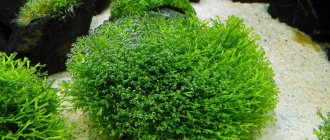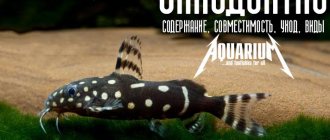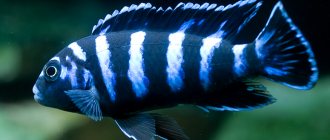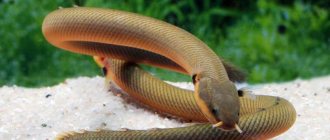Every beginner in the aquarium business after a while is faced with the fact that the water becomes cloudy and aquatic plants begin to grow uncontrollably. Cleaning an aquarium and putting it in order takes a considerable amount of time. But you can have assistants - one of them is a pond snail. She is a natural cleaner of walls and aquarium accessories. In addition, snails are no less interesting to watch than fish.
Appearance and structure of the pond snail
Lymnaeidae is the Latin name for the pond snail. They live in fresh, stagnant water or in bodies of water with slow currents.
The common pond snail has a fine-spiral shell with 5-6 curls, usually twisted to the right. Species with left-handed shells are found only in New Zealand and the Sandwich Islands. The degree of its elongation depends on the current in a given body of water - the width can be 0.3-3.5 cm, the height is from 1 to 6 cm. There is a large hole in the shell on the front side.
The color of the pond snail depends on the natural features of its habitat. Most often, sinks are in a brown palette. And the head and body are from yellowish-brown to bluish-black.
The body of a mollusk consists of three sections - head, trunk and legs. All these parts are tightly attached to the inner surface of the shell. The snail's head is large, there are flat triangular tentacles on the head, and there are eyes on the inner edges of them.
The mollusk breathes through an opening protected by a noticeably protruding blade.
Mr. Tail recommends: common types
The pond snail has many different species. The most famous of them are the following.
Ordinary (large)
The largest representatives of the pond snail, a large shell can have up to 7-8 spiral turns. The thin walls of the shell are translucent with a brown tint, and the body is grayish-green. Freshwater inhabitant.
Small
These mollusks are distinguished by a strongly elongated and pointed shell of a faded yellow hue. Its length is up to 2 cm, width - about 0.7 cm. The body is bluish-gray. Small pond snails live throughout our country - in shallow rivers, lakes, ponds, creeks and rain puddles.
There are four known subspecies:
- Physa snail. A small, symmetrical mollusk up to 10 mm in diameter, with a shell without spirals. Able to survive in moist soil and fresh water. A favorite inhabitant of aquariums and terrariums.
- Ancilida. The largest of this species of mollusk, the shell resembles a curved bagel.
- Horn-shaped coil. A small, agriculturally harmless snail with an almost transparent shell. When kept in aquaterrariums, it requires feeding with soft food; it is not able to eat algae.
- Allex snail. Up to 20 mm in diameter with a beautiful iridescent shell and a faded grayish body.
Swamp
The shell is in the form of a sharp, high cone (up to 35 mm high) and 10 mm wide. The shell is almost black, the body is greenish. Lives in muddy lowlands, at the beginning of swamps.
Ovoid
Very small and fragile pond snails up to 14 mm in diameter. The transparent or pale pinkish carapace ends in an ovoid mouth, in which an olive-gray body is hidden. Deep inhabitant of lakes and rivers.
Ear
The entrance to the shell is similar in shape to the human auricle. Up to 3.7 cm high and 3 cm in diameter. Painted in greenish-yellow tones.
It can live in small bodies of water, on wet rocks and vegetation.
Other species of pond snail are not as widespread, but are very diverse. So among them there are individuals living at a depth of 300 m and high in the mountains (up to 5.5 thousand m).
Varieties of pond snail
The species differ in the shell color characteristic of each locality, the thickness of its walls, the shape of the rings and mouth, the color of the legs and body.
The common pond snail (or large pond snail) is the most common species in the family of gastropods. The length of the shell, which has a conical shape, is 4.5-6 cm, its width is 2-3.5 cm. The spiral of the shell has 4-5 rings, which expand significantly with each revolution, ending with an impressive size hole. The color of the semi-translucent walls is brown. The body has a greenish-brown tint. This species inhabits freshwater bodies of the countries of the Northern Hemisphere everywhere.
The small pond snail (also called the truncated pond snail) has an elongated, pointed shell with 6-7 whorls. The turns of the rings are twisted to the right. The walls of the shell are thin but strong, whitish-yellow, almost transparent. It is 1-1.2 cm long, 0.3-0.5 cm wide. The body color is white-gray, uniform, but dark spots are possible on the mantle. This species is widespread in the nature of Russia, inhabiting swampy reservoirs and ponds. Sometimes found at low water levels in drying up reservoirs.
In the auricular species, the opening of the shell resembles a human ear - hence the name of this species. The shell is from 2.5 to 3.5 cm in height, 2.5 cm in width. Its walls are thin, the color is gray-yellow. This mollusk has no more than 4 shell rings. The shell has an almost round appearance, since the last whorl is quite large in diameter compared to others. The body is yellowish-green and grayish-green with many specks. The mantle is gray or spotted. Found in bodies of water with different water compositions. Lives on rocks, sunken tree trunks, stems and leaves of aquatic plants.
Other known species of pond snail:
- frilled (cloaked);
- oval (ovoid);
- swampy
general description
The pond snail has a well-developed shell, twisted to the right. The front part of the body is visible from the shell. The head is wide, with a pronounced cervical interception. The surface of the body that comes into contact with water is completely covered with small cilia.
The pond snail has a well-developed shell, twisted to the right
Movement is carried out with a powerful flat leg. It's long enough. In times of danger, the leg closes the hole in the shell where the snail hides. The sole secretes mucus required for movement.
The pond snail is the most common type of aquarium snail.
Pond snails are classified as pulmonary snails. Therefore, they need air to live. Breathing is carried out through the lungs. To renew the air, the individual must rise to the surface of the water. During inhalation, you can hear squelching sounds, which are called the voice of pond snails.
Habits in the wild and life expectancy
In their natural environment, pond snails feed mainly on plants. But sometimes they eat flies, fish eggs and other similar small aquatic life.
To breathe, they climb out from the water column to the very surface. A snail needs to rise at least 6-9 times a day. But for species that live at considerable depths, oxygen dissolved in water is sufficient. The mollusk takes water into the lung cavity, turns over in the water with its sole up and slightly pulls it into the shell.
In nature, a pond snail can rarely be found sitting motionless on some snag. The mollusk is almost constantly busy - scraping algae from stones and eating aquatic vegetation. The speed of movement of the pond snail is about 20 cm/min.
Despite the fact that pond snails spend most of their lives in the water column, they survive well in dry reservoirs and in water covered with a crust of ice. The mollusk simply seals the shell with a film, and when moisture appears or thaws, it comes to life.
On average, in the wild, the lifespan of a pond snail is only about 9 months. But with proper maintenance, a pond snail in an aquarium can live up to 2 years.
Interesting Facts
- Wild snails can serve as carriers (intermediate host) of the liver fluke (a dangerous parasite).
- They belong to the order of pulmonary mollusks and like to rise to the surface of the water.
- They densely inhabit Russian water bodies and are a common river snail.
- If the population of this species exceeds the normal limit, the pond snails are exterminated with lime. It can infect and kill a large number of livestock, being an intermediate host between animals and humans.
Aquarium content
The pond snail is a voracious mollusk. Therefore, it is better not to place them in carefully grown luxurious home “herbal gardens” - you may lose all aquatic plants. Snails especially like soft plants with succulent stems and leaves. But the pond snail is unpretentious in its maintenance.
Basic conditions:
- The water temperature in the aquarium should be maintained at 20-26°C. In warmer water, the mollusk will begin to actively reproduce, which is undesirable in a small volume of water.
- Water hardness is moderate, lighting is dim (optimally low-power fluorescent lamp).
- size of aquarium is suitable, the main thing is to control the population, not allowing pond snails to multiply endlessly. If there are too many individuals, diseases may develop.
- The soil needs to be rocky - pebbles are best, but a coarse sandy bottom is also acceptable.
- Clean the aquarium with pond snails as usual, replacing a third of the water every 7 days. filter , the direction of the stream is preferably horizontal.
Before introducing new pond snails, they must be kept in quarantine for several days. It is recommended to buy shellfish from pet stores. Since in the markets, snails can be freshly caught in a pond, and infect the entire aquarium with infections.
Who can you put in the same aquarium with?
Experienced aquarists recommend keeping only pond snails in the aquarium, arranging the interior specifically for them. Since these mollusks constantly eat plants, they pose a danger to fish, being carriers of parasites and infections. In addition, some popular types of aquarium fish (for example, loaches, gourami, tetraodons) enjoy eating shellfish.
It is not recommended to house the pond snail together with other types of snails.
Contact Hazard
Many experienced aquarists argue that it is best to keep pond snails in a separate aquarium. At the same time, preparing the necessary conditions for living. Since snails can destroy plants, they should be abandoned. The exception is hard-leaved varieties.
Many species of aquarium fish can eat shellfish. This may include:
- cockerels;
- macropods;
- cichlids
In addition, it is worth considering that pond snails are carriers of infectious diseases. Many diseases can be transmitted to other underwater species, destroying the entire fish population.
Feeding at home
Pond fish prefer plant foods. They do not require frequent additional feeding - algae, rotten parts of plants and fish waste are sufficient for nutrition. The mollusks, like a grater, scrape off all these remains from the walls and soil with long, powerful tongues. You can also give them:
- fresh pumpkin,
- apples,
- zucchini,
- white cabbage,
- broccoli,
- tomatoes,
- carrot,
- greens grown at the dacha (all cut into small pieces).
From time to time, pond snails need mineral feeding - calcium is needed for shells. It is found in chalk, egg shells, sepia - all this must be given in crushed form.
The small pond snail is a snail from the reservoirs of our country! Large pond snail Common pond snail
Pond snails are pulmonary mollusks. They are distributed throughout every world and live in fresh water bodies. People often have a lot of questions about the structure and functioning of these representatives of the animal world.
general characteristics
Representatives of the class of gastropods, one of the most countless and diverse groups in the world, live in lakes and rivers. The huge pond snail reaches five centimeters and has a cone-shaped shell twisted into a spiral. The shell not only serves as a home for the mollusk, it protects its soft parts. The shell is strongly connected to the muscles of the pond snail and consists of a green color. In the body of a pond snail, its main body parts, such as the head, torso and leg, are clearly visible. Transitions from one part to another are entirely devoid of sharp boundaries. The leg is the most powerful part of the body of a mollusk. When a mollusk needs to move, it initiates wave-like muscle contractions along the leg, thereby being able to move unhindered along the bottom of the reservoir. The leg is located on the ventral side of the body. A large pond snail, whose shell completely follows the shape of the body, has a huge head. There is a mouth on the lower part of the pond snail's head, and tentacles are visible on the side, which help the mollusk sense space. The animal also has eyes.
Digestive system of the pond snail
The large mollusk feeds on aquatic plants and small insects. It should be noted that the large pond snail is very voracious. With its tongue it gently scrapes off the top layer of the plant. He is helped in this by small teeth, which more closely resemble a grater. After the particles of the plant enter the pharynx, and then into the esophagus, they are sent to the stomach of the mollusk, where they are processed and go into the intestine of the animal. After some time, processed food is excreted through the anus.
Respiratory system of a pond snail
This type of mollusk has a round breathing hole, with the help of which the pond snail fills its lungs with clean air. Often these animals rise to the surface of the water and swim slowly. You can see exactly how the mollusk breathes; when inhaling, its breathing hole is as open as possible. The presence of lungs confirms the fact that the ancestors of pond snails were land mollusks. The walls of the lung of a mollusk are tightly intertwined with vessels; in this place, the blood fills with oxygen and releases carbon dioxide.
A mollusk must often rise to the surface of the water in order to breathe; on the contrary, an animal can simply disappear. On average, a pond snail rises to the surface of the water 7 times per hour. As unusual as it may seem, the mollusk has a two-chambered heart that beats up to 30 times per minute. The heart disperses the pond snail's blood through the vessels. It should be noted that the mollusk has colorless blood. The nervous system is located in the area of the pharynx; it consists of special nerve nodes that give impulses to each organism of the mollusk.
Pond snail behavior
The prudovik leads an energetic lifestyle. It continuously crawls among the thickets and scrapes off the top part of the plants. The speed of the mollusk reaches 25 centimeters per minute. It never stops at one area of water, but moves continuously. Even after catching a pond snail while relaxing in nature, a person can notice the exorbitant activity of this animal.
Often aquarium lovers want to take a pond snail to their home and place it with other fish. But we must remember that a pond snail caught in the wild and transferred to an aquarium with other fish can be dangerous. The fact is that it is impossible to exclude infections that the pond snail can infect the inhabitants of the aquarium; this can become a real disaster for the owner. The first thing you need to pay attention to is the signs of a large pond snail and its behavior.
Reproduction of pond snails
The large pond snail is a bisexual creature; therefore, during mating, individuals engage in mutual fertilization. The genitals look like oblong cords and are attached to any underwater objects. The egg cell is covered with a double protective shell and is dressed in a cocoon.
The pond fish can lay a clutch of about 300 eggs. But the number of eggs may vary. The most stunning thing is that, like the snail, the large pond snail does not have a developmental stage with the larva. The eggs hatch into a small pond snail with a thin shell. It is worth noting that not all pond snails become large individuals upon completion of adulthood. It all depends on nutrition and external factors. Not only huge pond snails live in reservoirs, but also small ones. The small pond snail is a small snail that can be found in all water bodies of the country. They can be found in springs and puddles, posing a great threat to humans. Such pond snails are carriers of flukes, and more often than not they are destroyed. Another fascinating species of mollusk is the toothless mollusk. The huge pond snail is very different from this species, but they can easily live in the same place. Toothless has a bivalve shell, which also consists of a joint. The circulatory system of the mollusk is very similar to the pond snail. The attorney of the Mikas family is also close to the pond snails. He has a very fragile shell. They live in lakes and ponds. They reproduce at an incredible rate, but each live for one season.
Among mollusks there are species that do not have a shell at all, such as slugs. All shellfish are an integral part of the food chain. Thus, mollusks eat small insects, but they themselves become food for fish. The shell is spirally twisted, without a lid. In some species (slugs) the shell is reduced. The ganglia are concentrated in the head region, forming the peripharyngeal nerve ring. A neural branch extends from the right parietal ganglion to the accessory azygos ganglion. Pulmonary molluscs have one atrium, one lung and one kidney. rice. 1. A - top view, B - side view: 1 - mouth, 2 - cerebral ganglion, 3 - pleural ganglion, 4 - parietal ganglion, 5 - visceral ganglion, 6 - liver, 7 - pericardium, 8 - lung, 9 - heart, 10 - kidney, 11 - stomach, 12 - gonad, 13 - mantle cavity, 14 - leg, 15 - head, 16 - anus, 17 - accessory azygos ganglion. (Fig. 2) is one of the largest land mollusks in Europe. The spherical-twisted shell has 4-4.5 cycles, reaches a height of 5 cm, a width of 4.5 cm. The shell is traditionally yellowish-chestnut in color with dark chestnut stripes running along it. The color and width of the stripes vary. On the head of a grape snail there are two pairs of tentacles, one of which contains eyes, the other serves as organs of smell and touch. It feeds on green parts of plants. By eating leaves and buds of grapevines, it can cause damage to vineyards.
rice. 2. Grape snail (Helix pomatia).
The grape snail is a bisexual animal. It has one hermaphrodite gland in which female and male gametes are formed. A hermaphroditic duct departs from the gland and flows into the protein gland. After the confluence of the protein gland, the hermaphroditic duct expands, forming two gutters: wide for eggs and tight for sperm. Further, all of the gutters are converted into independent channels, respectively, the oviduct and the vas deferens. The oviduct drains into the uterus, the uterus into the vagina. In addition to the oviduct, the ducts of the spermatic receptacle and bags with calcareous needles flow into the uterus. The vagina opens with a genital opening in a special skin invagination - the genital atrium. The vas deferens passes into the ejaculatory canal, which penetrates the copulatory organ, the one that opens into the genital atrium. During mating, grape snails exchange spermatophores (packets of sperm), which are captured by the spermatheca. Fertilization will occur after mating. Eggs that enter the uterus are fertilized by foreign sperm coming from the spermatic receptacle. The formed eggs are laid in a hole, which the parent individual digs in advance in the soil with its muscular leg. In a number of European countries, grape snails are used as food.
rice. 3. Large pond snail (Limnea stagnalis).
(Fig. 3) and
the small pond snail (L. truncatula)
are frequently encountered inhabitants of our fresh water bodies. The head bears one pair of tentacles, at the base of which there are eyes. Hermaphrodites. During mating, just like in a snail, sperm are exchanged and eggs are fertilized by foreign sperm. They lay eggs in mucus cords, which are attached to underwater plants and other objects. The formation is direct, without a larval stage. They breathe atmospheric oxygen, and therefore periodically rise to the surface of the water in order to gain a share of air. The size of the shell, its shape, the color of the leg and body are characterized by strong variability in the large pond snail. For example, the color of the body and legs can vary from blue-black to sandy yellow. The length of the shell of a large pond snail can reach 7 cm. The huge pond snail is omnivorous, feeding not only on plants and small animals, but can eat dead plant remains and animal corpses. rice. 4. A - Arion rufus, B - Limax maximus. A collective group of terrestrial pulmonary mollusks with a partially or completely reduced shell (Fig. 4). On the head, next to the mouth opening, there is a pair of labial tentacles, and on top there are ocular tentacles bearing eyes. The narrowed portion of the body between the head and mantle is called the “neck.” At the bottom of the neck, a gland duct opens that secretes mucus. In addition to this gland, countless mucous glands are scattered over every surface of the body, therefore the entire body of the slug is covered with mucus. The main purpose of mucus is to moisturize the skin. On the right side of the neck is the genital opening. The mantle looks like a flat thickening on the dorsal side of the body. Near the right edge of the mantle there is a respiratory opening leading to the pulmonary cavity. Near the respiratory opening on the right edge of the mantle, the anus and excretory pore open. Slugs are bisexual animals. During mating, male gametes are exchanged. Eggs are laid in damp, shaded areas. Most slugs feed on plants, lichens or fungi. Predatory slugs feed on oligochaetes or other types of mollusks. They are energetic at night and stay hidden during the day. Slugs settling in areas occupied by agricultural crops can cause significant damage to crop plantings. For example, the field slug (Agrolimax agrestis) eats sown grains and seedlings of winter wheat and rye, and the netted slug (Deroceras reticulatum) causes major damage to the crop of tomatoes and cabbage. Description of classes, subclasses and orders of the Mollusc type:
- Class Gastropoda Subclass Pulmonata
Common pondweed
- lat. Limnaea stagnalis, a type of mollusk, belongs to the class Gastropods. The specificity of the ordinary pond snail, like all members of the pond snail family, is its original swimming in water. A special organ (leg) is directed upward during movement, protruding slightly on the surface of the water. To prevent an ordinary pond snail from drowning while moving, the middle of the leg bends down, thus acquiring the shape of a boat, while the animal’s shell is directed down to the bottom. Such an original movement is not yet clear to scientists.
Structure
The snail's eyes are located at the base of the 2nd pair of tentacles. The breathing of an ordinary pond snail is carried out by one lung, which is a modified mantle cavity. The air in the lungs, in the peaceful state of the mollusk, prevents it from falling to the bottom. But if at this time you touch an ordinary pond snail, then it quickly releases air from the respiratory tract and instantly falls down. It also has one kidney and one atrium. The shell of a common pond snail has the shape of a twisted spiral. Characteristics of the animal:
Dimensions: length of the mollusk is 5 - 7 cm. Color: the common pond snail has a variable color, from dark blue to yellow. The sink has a thin translucent design.
Food and habitat
Common pond snails are omnivorous animals; they can feed on both plant and animal food, preferably algae, aquatic plants, uruti leaves, etc. Common pond snails are widely distributed across every globe, preferably in ponds, rivers, lakes, etc. They live at shallow depths. A representative of the family of freshwater mollusks of the order Grey-eyed. It has an elongated, powerfully pointed shell towards the apex, curled to the right, as usual, thin and translucent. The curls of the shell expand very rapidly and the final, so-called belly, occupies the most significant part of the shell. Its color is pale yellowish. The pond snail, like the reel, is one of the mollusks with pulmonary respiration and therefore from time to time floats to the surface in order to inhale atmospheric air. Its body is greenish-dark gray with yellow spots. The head is equipped with two triangular flat tentacles, at the base on the outer side of which there are eyes. The leg is shorter than the reel leg, but much wider. From the leg, the body inside the shell rises upward in a spiral and forms, closer to the opening of the shell, a kind of sac that contains a mass of vessels and serves as a respiratory organ. On its right side there is an opening for air intake, which is closed by tightly locking muscles. The hole and each respiratory organ are easily visible when the animal, crawling along the plant, turns and often crawls out of the shell completely. This often happens when the pond snail, like a reel, crawls with its foot along the surface of the water, which it does in order to breathe atmospheric air. Under the head there is a mouth opening, consisting of an upper jaw and 2 lateral falciforms. A long tongue is also placed here, the one that rakes in algae. This can be seen most clearly when a pond snail crawls along the glass of an aquarium. Pond fish are bisexual animals, and therefore they can be found mating in groups of 6-10 together. Pond snails lay eggs on the lower surface of floating leaves, on glass in an aquarium and on various objects. The caviar is not combined in the form of a flat cake, but in a worm-shaped or oval shape, similar to an icicle. From May to August they lay up to 20 such icicles, and each icicle contains 20-100 eggs. The eggs are transparent. The formation of the embryo proceeds rapidly, and after a few days the embryo, covered with ciliated hairs, begins to rapidly rotate. The snails hatch from their eggs no earlier than after twenty, and occasionally after forty days, which, according to each probability, depends on both the temperature of the water and the intensity of the lighting. With the gelatinous mass of eggs of these snails, a significant phenomenon is occasionally observed. It is covered with some kind of mold - small cilia with a pin-shaped thickening at the end, probably lily of the valley. These creatures probably help break this mass. The snail reaches large sizes, and therefore is not at all comfortable for an aquarium. This inconvenience is further increased by the fact that it grows so rapidly and reaches large sizes in a short time. Along with its rapid growth, this snail is distinguished by its gluttony, which preys on aquarium plants, with particular preference being given to plants that are at the same time soft and tasty. When young, the pond snail is not dangerous because it is small and its appetite is insignificant. Pond fish are capable of eating the corpses of their own brothers. Limnea stagnalis (common pond snail) also belongs to the same genus of pond snails.
, even larger than the above.
The common prudovik is a particularly well-known family attorney in Europe. It feeds on waste and carrion that other animals do not consume.
Class
—
Gastropods Series
—
Basommatophara Genus/Species
—
Lymnaea stagnalis Basic data:
DIMENSIONS
Shell length:
45-70 mm.
Shell width:
20-30 mm.
REPRODUCTION Mating season:
spring or summer, when the water warms up.
Reproduction type:
pond snails are hermaphrodites.
Number of eggs:
200-300 eggs in cords attached to underwater objects.
The eggs hatch into tiny copies of the adults. LIFESTYLE Habits:
stay alone in stagnant bodies of water and rivers with a slow flow.
Food:
organic waste and algae, occasionally carrion.
Life expectancy:
3-4 years. RELATED SPECIES About 100 species belong to the pond snail family, say, long-eared, marsh and small pond snails. The common pond snail lives in water, but breathes atmospheric air. This is why it can inhabit reservoirs with stagnant water, which contains a minimum amount of oxygen. In such swamps and lakes there is a lot of rotten plant and animal remains - the core food of the common pond snail.
REPRODUCTION
Pond fish are hermaphrodites. Every individual has both male and female reproductive organs. Despite this, during mating, both partners mutually fertilize each other. Later, pond snails lay eggs in long dragnet cords. The cords are attached to underwater parts of plants and rocks. Occasionally they even stick to the shells of other individuals. Pond snails do not have a free-swimming larval stage. In every egg, an embryo develops, which, after emerging from the shell, resembles a smaller copy of the adult individual.
LIFESTYLE
Many snails that live underwater breathe using thread-like gills. The gills of these cephalopods contain a lot of blood vessels. Animals easily obtain oxygen from water. However, in the common pond snail, the respiratory organs have the shape of pulmonary sacs. The mantle cavity of these cephalopods, which is connected to the external environment only through a small respiratory opening by a pneumostome, penetrated by a dense network of small blood vessels. It functions similarly to the human lungs. The disadvantage of this type of breathing is the need to surface every 15 minutes or so in order to replenish air reserves. However, due to this respiratory organ, the pond snail can live in reservoirs with low oxygen levels. The pond snail can move freely from the underside of the surface film of water. This is permissible due to the fact that, with the help of the lungs, the mollusk scoops up a large amount of air, which lifts it to the very surface.
FOOD
In stagnant water, organic substances and microbes settle on submerged tree trunks or stems of aquatic plants, which contribute to their decomposition. Pond snails eat this layer of organic debris, waste, bacteria, protozoa, blue-green algae and mud. These mollusks are omnivores. The snail also feeds on eggs and larvae of other aquatic animals, and also attacks wounded fish, tadpoles or newts. With the support of the radula, pond snails eat the leaves of water lilies and scrape algae from the lower surface of water lily leaves. The radula of gastropods resembles a sharp file, one that is continuously renewed, due to the fact that it is quickly erased. The anterior worn teeth on the radula are periodically replaced by new sharp teeth. The basis of the radula is chitin, a chemical compound found in the durable shells of insects. The pond snail's radula acts like a grater. Carnivorous snails, with the help of the radula, make a hole in the shell of other mollusks and get inside. Under unfavorable conditions, the growth of pond snails stops.
OBSERVING THE PRODUCER
Common pond fish are found in ponds, lakes or rivers. They can only live in rough water. From rough water, pond snails obtain lime, which they need to build a house and shell. In areas where the bedrock is limestone or similar sedimentary rocks, pond snails can live virtually anywhere: in small lakes, ponds, water-filled ditches, irrigation canals and rivers. Ordinary pond snails can be placed in aquariums, where they slowly travel across the glass and scrape off a layer of algae from it with their radula. These gastropods can swim close to the surface on the underside of the water film. The disturbed pond snail falls to the bottom.
DID YOU KNOW THAT...
- The shape of the common pond snail's shell depends on the habitat of a particular individual. These mollusks are very variable; not only their size, color, shape, but also the thickness of the shell varies.
- The small pond snail is one of the smallest confidants of the family. It lives not only in reservoirs, but also in flooded meadows and pastures. The small pond snail is an intermediate owner of the liver fluke, which causes fascioliasis in sheep and huge cattle.
- The shells of all European species of pond snails are twisted to the right. Only as an exception are there individuals with left-handed (leotropic) shells.
FEATURES OF THE COMMON PONDOWER
Horn Coil:
a close relative of the pond snail lives in the same habitat.
However, it is much smaller than the pond snail, in addition, it has a shell of a different shape. Occasionally you can see a horn-like coil that is attached to the shell of an ordinary pond snail. Tentacles:
grow from the sides of the head, they are flattened and triangular, which invisibly distinguishes them from the thread-like tentacles of other species of snails.
The tentacles perform only the function of an organ of touch. The eyes are located at their base. Shell:
ends with a long apex.
Consists of communication and is covered with a yellowish stratum corneum. It is quite thin and easily damaged. Eggs:
The pond snail lays eggs in long, draggy cords that stick to various underwater objects.
The number of eggs in a clutch varies between 200-300 pieces. The eggs are surrounded by a mucous mass, which is dressed like a special capsule or cocoon. Hatched from eggs, outwardly resembling tiny copies of their parents. LIVING PLACES
The pond fish lives in ponds with stagnant water and in rivers with a slow flow.
It is found in Central, Western and Southern Europe, South-West Africa and Asia Minor, and from there the range of the pond snail reaches South-West India. PRESERVATION
Prudovik are not in danger of extinction, but they are currently becoming clogged with the natural environment.
Breeding
Pond fish are hermaphrodites. They reproduce either singly or in flocks. Eggs are laid several times throughout the year. That is, during a lifetime they hatch offspring from about 500 clutches. Clutches of eggs are attached to plant leaves.
The clutch consists of small transparent eggs fastened together with mucus, forming an oval-shaped sac. If favorable conditions contribute to this, one individual makes up to 25 clutches of 80 eggs within 4 months.
The incubation period is 14-20 days. Newly hatched babies already have thin shells.
Sexual maturity in pond snails occurs at approximately 7 months.
